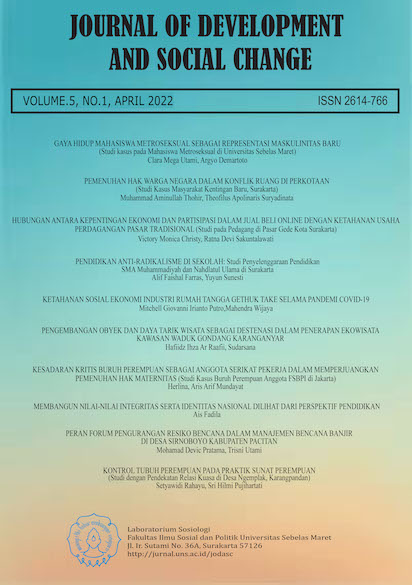GERAKAN ECOTON DALAM UPAYA PEMULIHAN SUNGAI BRANTAS
Abstract
Most of Indonesia’s rivers fall into the heavily polluted category. One of the heavily polluted rivers in Indonesu is the Brantas River. This research had purpose to understanding the problems in Brantas River and also to know the environmental movement in order to recovering Brantas River. The theory which was used in this research was New Social Movement theory from Rajendra Singh. This research was qualitative research with etnography methods. Data was obtained by observation, detailed interview, and also documentation. The subject of this research was Ecoton, the public accompanied by Ecoton on the headwaters and the downstream of the Brantas River, and the school accompanied by Ecoton. Researcher was using source triangulation techniques to test the collected data legitimation. Researcher used Miles and Huberman’s outlook in data analysis, which consist of three activity lines; data reduction, data presentation and draw conclusions.
Results show that there were many problems happened in Brantas River from the headwaters to the downstream. There were five problems found in this research. First, problems in Brantas River headwaters was reclaiming the land functions and illegal logging. Second, there were many abandoned buildings on the riverside. Third, domestic pollution from household. The buildings which were built on the riverside had made the people to easily throw away their garbages to the Brantas River. Mostly it was diapers, which could endanger human and the fishes whom lives in Brantas River. Fourth, the industrial pollution which already exceeds the permittable treshold. Industry had oftenly disposed their waste to the river without conducted the sewage management procedure which then created the new problems in Brantas River: a mass death fish. A mass death fish had become the fifth problems in Brantas River. The damage of environmental condition of Brantas River had pushed the movement from Ecoton. In their movement, Ecoton had the characteristic new social movement which was the ideology of care to the Brantas River damage. The strategy which was used by Ecoton were conducted partitions research, environmental education, advocation and also involved the media on every movement they had done. Ecoton had the non-institutional structure, which was unconcerned with power but put their focus to reach the aims and the visions.Full Text:
PDFReferences
Agustiningsih, Sasongko, Sudarno. 2012. “Analisis Kualitas Air dan Strategi Pengendalian Pencemaran Air Sungai Blukar Kabupaten Kendal” Jurnal Presipitasi Media Komunikasi dan Pengembangan Teknik Lingkungan Vol 9 No 2, 64-71. https://ejournal.undip.ac.id/index.php/presipitasi/article/viewFile/4928/4465 Diakses pada 23 Nov 2018
Anandriyo Suryo Mratihatani. 2013. Menuju Pengelolaan Sungai Bersih di Kawasan Industri Batik Yang Padat Limbah Cair. (Studi Empiris : Watershed Sungai Pekalongan di Kota Pekalongan). Fakultas Ekonomika dan Bisnis Jurusan Ilmu Ekonomi Studi Pembangunan Universitas Diponegoro.
Bect, Manuel, Salvador, dkk. 2013. “The use of urban wastewater for the Colorado River delta restoration” Journal Procedia Environmental Sciences 18, 829-835.
Della Porta, Donatella and Mario Diani. 1999. Social Movements: An Introduction. Oxford: Blackwell.Development: Case Studie From Indonesia. Leiden: CNWS.diakses pada tanggal 9 Desember 2018 di
Erfan Nilasmani. 2009. Peranan Lembaga Swadaya Masyarakat Ecoton Dalam Menanggulangi Pencemaran Di Kali Surabaya (Studi Kasus Di Lsm Ecoton). Fakultas Hukum Jurusan Perdata Universitas Muhammadiyah Malang.
Junus, George Aditjondro. 2003. Pola-Pola Gerakan Lingkungan. Yogyakarta: Pustaka Pelajar.
Kuemmerlen, Peter, dkk. 2018. “Ecological assessment of river networks: From reach to catchment scale” Journal Science of the Total Environment 650, 1613-1627.
Made, Pande Kutanegara. 2012. Manusia, Lingkungan dan Sungai. Yogyakarta: UGM Pers
Maryono, Agus. 2017. Reformasi Pengelolan Sumber Daya Air. Yogyakarta: Gajah mada University Press.
Mochamad Riszal Pratama. 2015. Kampanye Sosial Tentang Kesadaran Lingkungan (Studi Pada Lembaga Swadaya Masyarakat Lingkungan Ecoton Gresik). Fakultas Dakwah Dan Komunikasi Jurusan Komunikasi Universitas Islam Negeri Sunan Ampel Surabaya.
Novianti, Kurnia. 2013. Peran NGO sebagai Bagian dari Civil Society dalam Mitigasi Banjir di Praha. Global & Strategis. Th. 7, No. 2. LIPI : Jakarta.
Pusarperdal. 2011. Fakta Pengelolaan Sungai Indonesia. Jakarta: Kementerian Lingkungan Hidup.
Quina, Margaretha. 2017. Cls Sebagai Salah Satu Instrumen untuk Mendorong Laju Pemulihan Sungai: Pembelajaran dari Sungai Gangga dan Riachuelo. Jurnal hukum Indonesia Vol. 3 Issue 2. diakses pada tanggal 8 Desember 2018 di https://icel.or.id/wp-content/uploads/Jurnal-HLI-Vol.-3-Issue-2-Maret-2017.pdf
Salam, Burhan Fauzi. 2018. Upaya Restorasi Daerah Aliran Sungai dengan Pemanfaatan Lahan Basah Buatan”. PSLP. Universitas Brawijaya.
Singgih Hermanto, 2015. Menyelamatkan Kali Mas di Surabaya. Fakultas Sastra Jurusan Ilmu Sejarah Uiversitas Jember.
Singh, Rajendra. 2010. Gerakan Sosial Baru. Yogyakarta: Resist Book.
Sudaryanti, S. 1997. Prosiding Pelatihan Strategi Pemantauan Kualitas Air Sungai Secara Biologis, Fakultas Perikanan Universitas Brawijaya. Malang.
Sugiyono. 2010. Metode Penelitian Pendidikan Pendekatan Kuantitatif, Kualitatif, dan R & D, Bandung: Alfabeta.
Tommy, 2018, Popok, Limbah Berbahaya yang Cemari Sungai-sungai di Jawa, Mongabay, di akses pada 2 September 2018.
Wahib, Abdul Situmorang. 2013. Dinamika Protes Kolektif Lingkungan Hidup di Indonesia (1968-2011). Yogyakarta: Pustaka Pelajar.
Widodo, Kasam, dkk. 2013. “Strategi Penurunan Pencemaran Limbah Domestik di Sungai Code DIY” Jurnal Sains dan Teknologi Lingkungan Volume 5, Nomor1 hal. 36-47.
Wijayanto, 2018, Hilir Brantas Tercemar Limbah Industri, Radar Surabaya, di akses pada 25 Juli 2018.
DOI: https://doi.org/10.20961/jodasc.v2i1.41653
Refbacks
- There are currently no refbacks.




